Key takeaways
- Google’s core systems still lead – AI Overviews use PageRank, Reviews, and Helpful Content to rank results.
- AI models guide ranking – Systems like Gemini, PaLM 2, and MUM shape how AI Overviews generate answers.
- Google’s databases inform results – Shopping Graph and Knowledge Graph provide key contextual data.
- Topic and intent matter – Informational or YMYL topics influence visibility in AI Overviews.
- Structured data and visuals help – Schema markup and multimedia boost your chances of being featured.
What are AI Overviews?
AI Overviews are AI-generated snapshots for Google Search results. These snapshots help users search faster by sharing baseline information about a topic, along with links for learning more about the topic, like the difference between dark and medium roast coffee (see the image above).
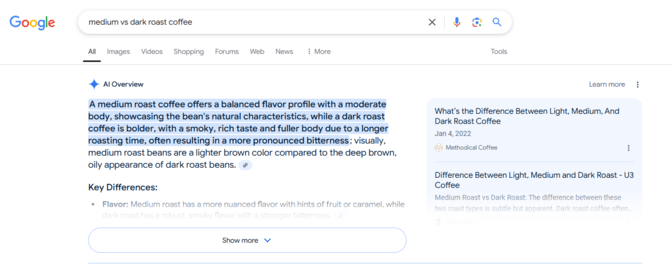
In this guide:
- When Do Google’s AI Overviews Appear?
- Check if Your Site Appears in AI Overviews
- What Determines AI Overview Rankings?
- How Do AI Overviews Impact SEO?
- How Do I Track My Performance in AI Overviews?
- How to Rank in Google’s AI Overviews
When do Google’s AI Overviews appear?
According to Google, AI Overviews appear when its systems “determine that generative AI can be especially helpful.” Recent research has shown AI Overviews appearing in 30% of searches, with informational searches being the most popular.
From a user perspective, these AI-powered featured snippets make sense.

Consider a group of friends looking to settle a debate — what has more caffeine, coffee or tea? A Google search reveals the answer in an AI Overview: Coffee generally contains more caffeine than tea. Nowhere else on the search result is the answer so direct.
Debate settled.
Check if your site appears in AI Overviews
Are you unsure if your website is appearing in AI Overviews? Our free AI Overview Checker will let you know! Not only that, it will display some crucial information for how organic results are informing the AI Overviews, and how your site can improve.
What determines AI Overview rankings?
Our research into the ranking factors behind AI Overviews found the following ranking factors:
- Google’s core ranking systems, like PageRank, Reviews, and Helpful content
- AI models, like Gemini, PaLM 2, and MUM
- Databases, including Shopping Graph and Knowledge Graph
- Topic, like whether the topic is Your Money, Your Life (YMYL)
- Search intent, like whether the search is informational vs. transactional
- Multimedia, like videos or images
- Structured data, like LocalBusiness, Product, and FAQ
How do AI Overviews impact SEO?
As a user, AI Overviews can make finding information faster. But what about as an SEO?
AI Overviews impact search engine optimization (SEO) in three ways:
1. Visibility
Google’s AI-powered snapshots appear at the top of search results and encompass more than 1700 pixels. Within this snapshot, users can view the AI-generated answer, plus its top three links to explore (if desired, users can toggle the snapshot to show all recommended links).
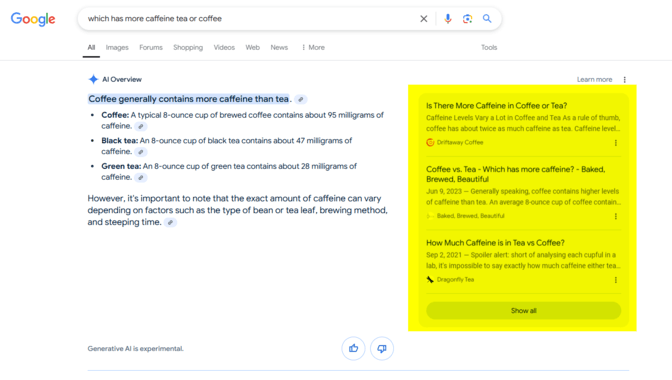
While websites in the top three will benefit from the AI Overview callout, sites outside that list will see decreased visibility. Traditional organic results, for example, will see themselves moving down the page by more than 140%.
This change emphasizes the importance of earning a spot in AI Overviews (which often correlates with ranking well in traditional search results — the top three links in the AI Overview for “which has more caffeine tea or coffee” also rank in the top ten below).
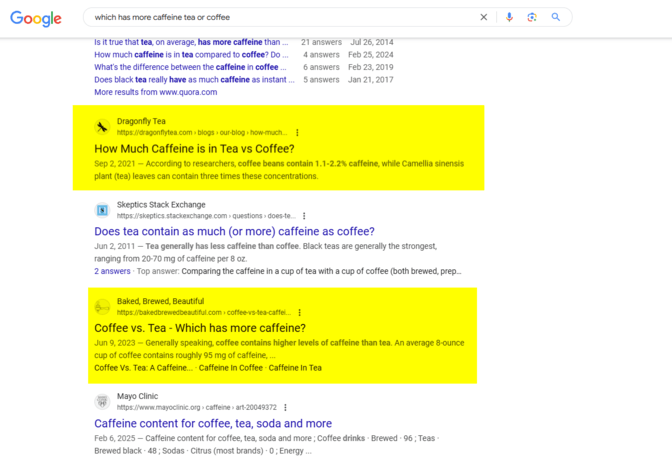
The addition of ads in AI Overviews also impacts a business’s organic visibility — or doubles it if they’re advertising.
2. Traffic
Like featured snippets, AI Overviews can instantly answer a user’s question— eliminating the need to visit a website and creating a zero-click search. The upside to this decline is the chance of attracting more qualified traffic.
In fact, more marketers are reporting a decline in traffic but a rise in revenue. Companies like HubSpot saw this story play out publicly when its organic traffic was claimed to have dropped 80% — the business, however, saw a 21% growth in revenue for 2024.
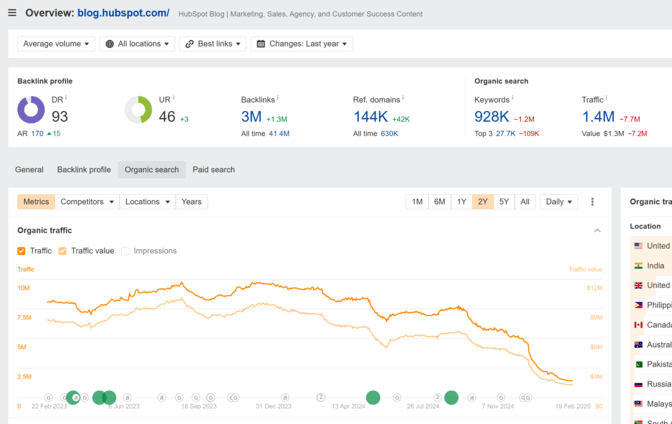
Consider the earlier example: “which has more caffeine tea or coffee”
You don’t need someone who’s debating the answer with a group of friends as a website visitor. That person will most likely land on your site, find the answer to their question, and end their session. Their interest in your product or service is zero.
In comparison, someone considering a lifestyle change — like reducing their caffeine intake — is more qualified. Their visit could result in a more qualified session, like reading the page further to understand how caffeine levels vary by the type of tea or coffee.
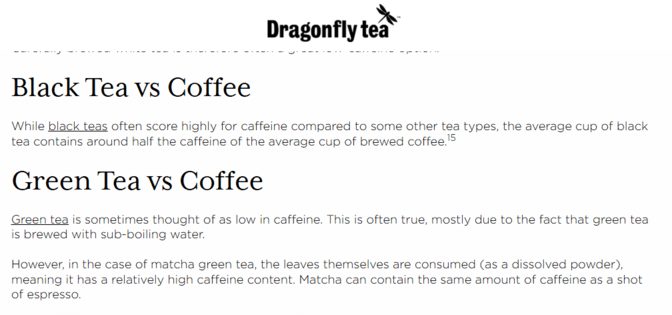
For SEOs, this change is one of the most difficult to navigate. A key part of navigating it is understanding which queries are most likely to result in a zero-click search. Our AI Overviews SEO Impact Study provides crucial data on this, revealing how the prevalence of AI-generated answers differs across various keyword categories.
Besides resetting expectations (sites are expected to lose 25% of organic traffic due to AI offerings like AI Overviews), SEOs have to communicate to leadership that search engine optimization is still a worthwhile investment because good SEO is key to appearing in AI-powered experiences.
3. Revenue
AI Overviews can also impact SEO revenue.
This scenario usually happens when businesses practice bare-minimum SEO or pause SEO efforts. There is consistent research that shows companies ranking well in organic search results are more likely to rank in AI Overviews:
- 74% of the three websites in AI Overviews rank in the Top 10 (Authoritas)
- 73% of websites in AI Overviews rank in the Top 10 (SE Ranking)
However, it’s worth mentioning that Google continues to develop AI Overviews. The company plans to invest $75 billion in artificial intelligence projects and has seen returns in traffic and ad revenue from AI Overviews. Learn more about the future of AI Overviews.
Altogether, these changes in visibility, traffic, and revenue challenge SEOs to rethink their:
- Success metrics
- Optimization strategy
- Leadership reporting
You can learn more about tackling these challenges in our AI SEO Library →.
Altogether, these changes in visibility, traffic, and revenue challenge SEOs to rethink their success metrics, optimization strategy, and leadership reporting. For businesses looking to tackle these challenges head-on, generative engine optimization services are specifically designed to secure visibility in this evolving search environment.
How do I track my performance in AI Overviews?
You don’t — at least not without the help of a third-party tool.
While impressions, clicks, and average position data from AI Overviews (and AI Mode) enters Google Search Console, it’s not filterable. You can’t separate AI Overview data from traditional search result data. Various SEOs have tried workarounds, but most of these have limitations in their effectiveness.
One of the most comprehensive third-party tools for AI Overview tracking is OmniSEO®.
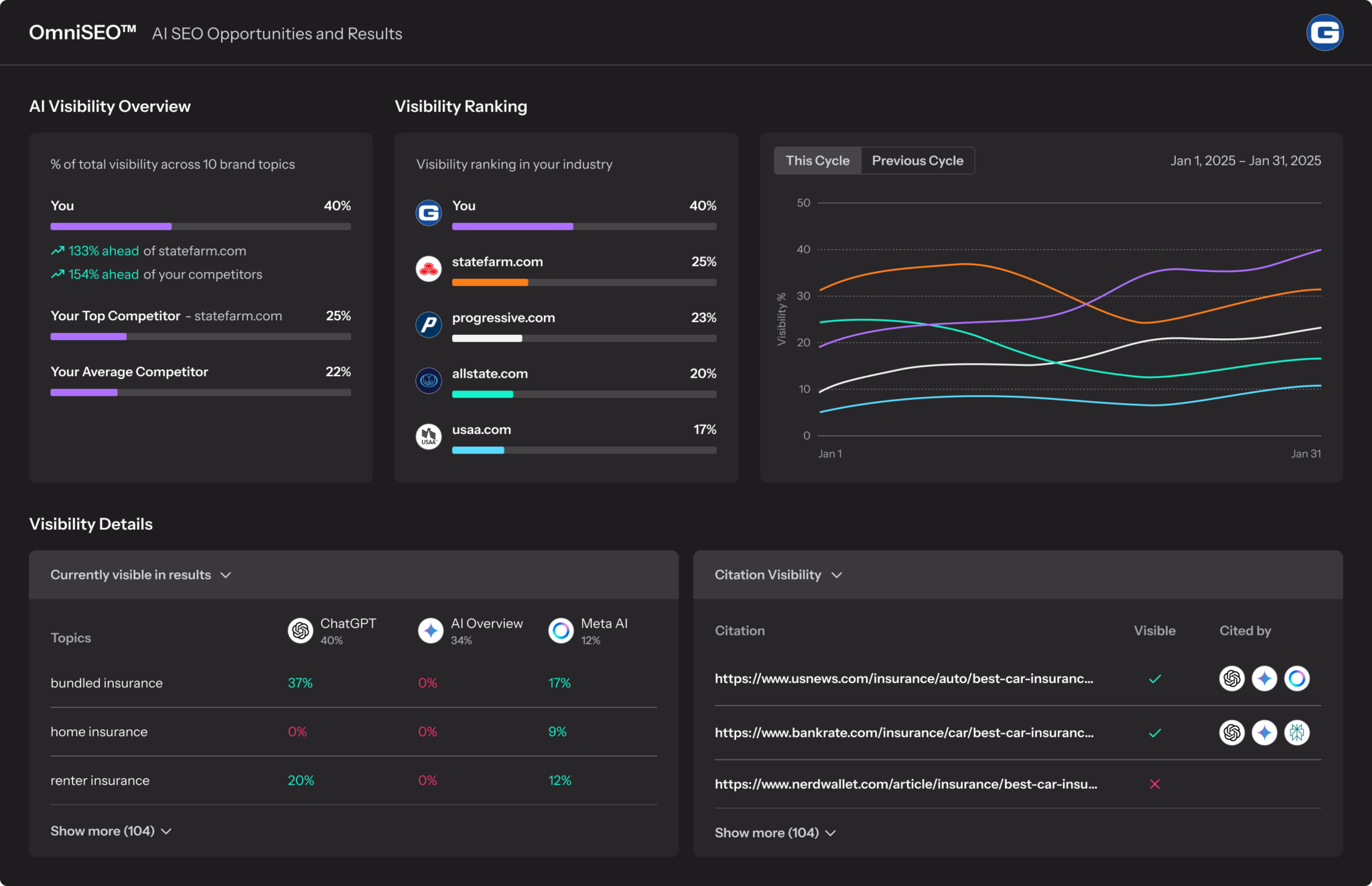
With OmniSEO®, businesses can track their visibility across AI-powered experiences, like in:
- AI Overviews
- ChatGPT
- Perplexity
- Microsoft Copilot
- Meta AI
- Apple Intelligence
- And more
They can also monitor how well competitors rank for different searches, eliminating the manual process of searching, logging, and then doing it all over again in a few weeks. While there are free alternatives, like ZipTie.dev, there is nothing as comprehensive as OmniSEO®.
How to rank in Google’s AI Overviews
The most effective strategies for how to rank in Google’s AI Overviews include:
1. Follow SEO best practices
As a part of AI Overviews, Google re-uses its core ranking systems, which span areas like:
- PageRank
- RankBrain
- BERT
- Content helpfulness
- Content freshness
- Reviews
- And more
Following best practices that align with these systems will give your business a baseline for appearing in AI Overviews. In most cases, companies looking to enter AI Overviews already practice SEO.
For example, consider:
- Producing unique, helpful, and timely content
- Acquiring relevant backlinks via useful content, tools, or studies
- Attracting online reviews, like on Google Business Profile and other third-party sites
- Establishing a thoughtful site architecture for user and crawler navigation
- Researching and incorporating relevant phrases into URLs to reach users
Get Inspired With SEO Examples
2. Add character to content
Generative AI engines like ChatGPT, Microsoft Copilot, and AI Overviews respond to content with the following:
- Anecdotes, like first-hand experiences
- References, like to recent studies, internal data, and news stories
- Direction, like “Monitor for 10 days” vs. “Monitor the data.”
This optimization is similar to E-E-A-T enhancements — or Experience, Expertise, Authoritativeness, and Trustworthiness. Speaking with client-facing team members and keeping up to date on industry changes are great options for bringing this optimization to life.
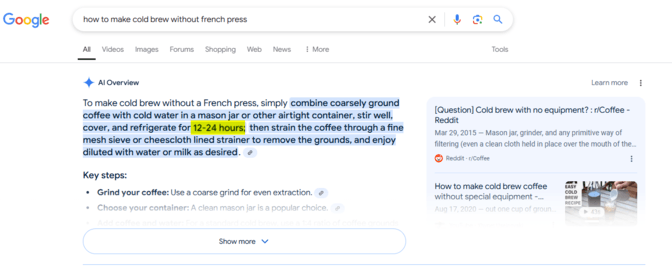
The example above shows how Google’s AI Overviews value content with character.
With that answer, users don’t have to browse a forum or website to make cold brew without a French press. The answer is there — from how to prepare the grounds and where to store them to how long to store them for and how to serve the cold brew the next day.
3. Anticipate next-step needs
It’s all in the name — AI Overviews provide an overview of a topic.
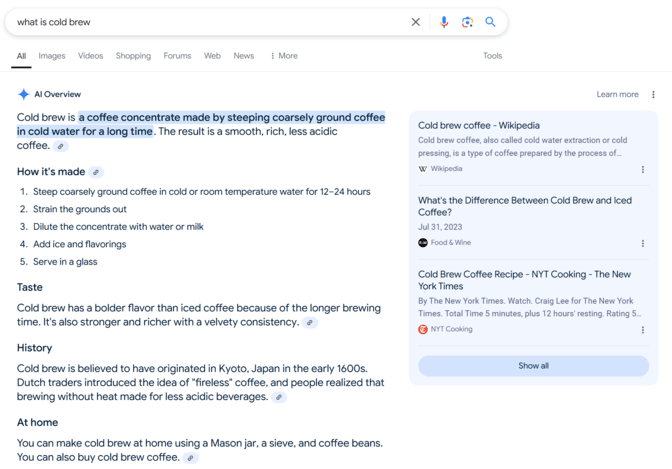
A search for “what is cold brew,” for example, answers the following questions:
- What is cold brew?
- How is cold brew made?
- What does cold brew taste like?
- Where did cold brew come from?
- How do you make cold brew?
That’s a lot of information — and a guide on cold brew can answer all of them by considering what users want to learn first, second, third, and so on about cold brew. So, when developing SEO content, consider a user’s next step or need and incorporate it into the page.
4. Use structured data
Using structured data is like completing a direct call to search engines. That’s because structured data provides direct and organized information to search engines about a URL, like highlighting the product on a URL and that product’s pricing, inventory, and more.
For example, look at this AI Overview for “how long does it take to make cold brew coffee.”
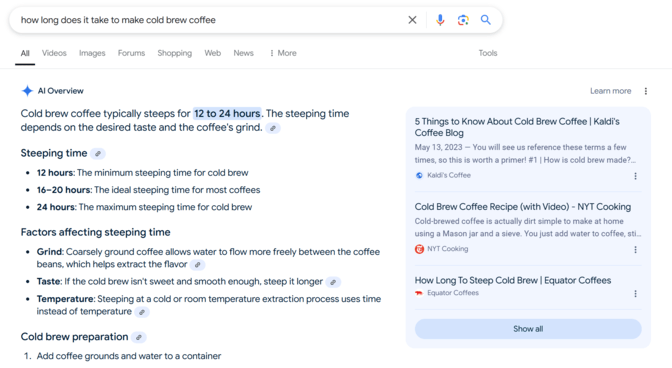
The AI Overview cites an NYT Cooking article, which uses Recipe markup:

Google’s AI Overview specifically cites that article when explaining how to prepare cold brew:
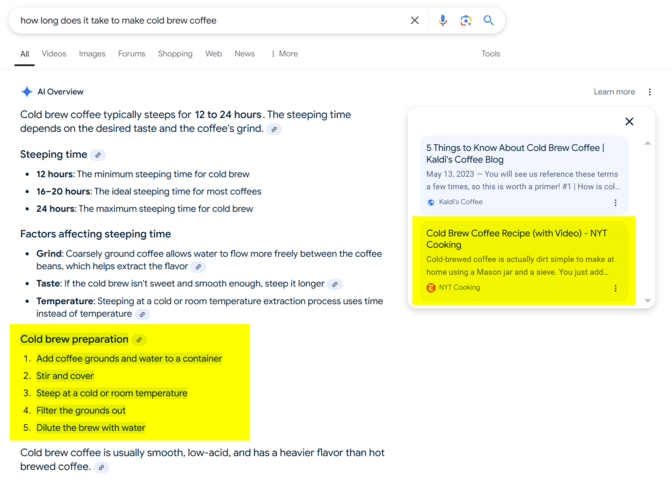
Free markup generators like Structured Data Markup Helper make creating structured data for your website easy. Some common examples include Recipe, Product, FAQ, and Articles. Just remember — use markup that accurately describes your page.
5. Include multimedia
There are tons of multimedia options available for web content, including:
- Video
- Image
- GIF
Multimedia gives users other options for interacting with content, like watching a video to understand the difference between cold brew vs. iced coffee (as seen in the AI Overview below) or following a complex process, like cell division, using a graphic.
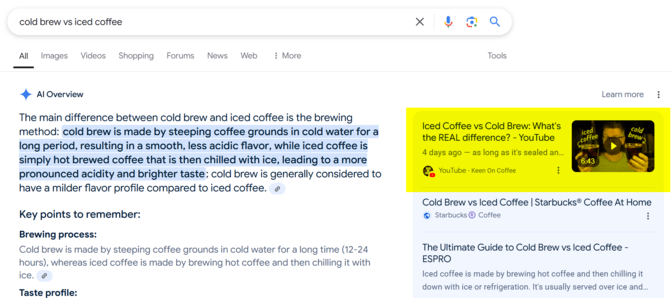
When developing multimedia for content, consider what would help users — and level up your content. For example, someone reading an introductory guide on cell division will likely find a graphic outlining the phases helpful:
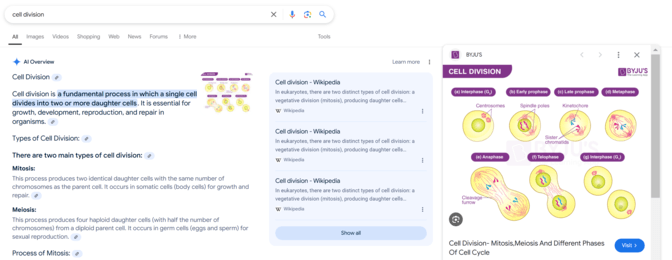
There are various options for creating multimedia, like working with a freelancer or using a free tool like Canva. Either way, remember to follow SEO best practices. For example, write alt text for images and upload videos to YouTube (Google’s AI Overviews are more likely to cite YouTube videos).
Learn more:
- How to Rank on Answer Engines
- AEO vs. SEO
- How to Use AI in Digital Marketing
- What is Omnichannel SEO?
Rank in AI Overviews — and prove it with OmniSEO®
You’ve learned the basics of AI Overviews, from where to find them to how to track them. Now, start getting all the benefits, from increased visibility to improved traffic quality — and track your progress with OmniSEO®!
See where you rank by requesting a free demo of OmniSEO®!

Future-Proof Your SEO Strategy with OmniSEO™
Goodbye search engine optimization, hello search everywhere optimization.



Future-Proof Your SEO Strategy with OmniSEO™
Goodbye search engine optimization, hello search everywhere optimization.
Writers

Related Resources
- AEO vs. SEO: Key Differences and Importance in Digital Marketing
- AI Advertising in 2025: Use Cases, Tools, and Best Practices
- AI and SEO
- AI Marketing in 2025: Use Cases, Examples, and Best Practices
- AI SEO Statistics in 2025: AI SEO Trends and Insights
- An Exploration into the Newest ChatGPT Experience: ChatGPT Pulse
- ChatGPT Advertising: Inside Your (And OpenAI’s) Next Revenue Channel
- Do AI Search Engines Respond the Same to the Same Query? An Exploration
- Do I Need AEO? Yes, if You Want to Stay Competitive
- How to Appear in ChatGPT Answers: a Guide for Businesses



